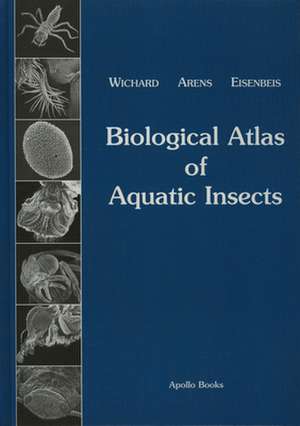Biological Atlas of Aquatic Insects: With a foreword by Vincent H. Resh
Autor Wilfried Wichard, Werner Arens, Gerhard Eisenbeis Contribuţii de Vincent H. Resh Caroline Coiten Limba Engleză Hardback – 31 dec 2001
Preț: 532.19 lei
Preț vechi: 649.02 lei
-18% Nou
Puncte Express: 798
Preț estimativ în valută:
101.85€ • 110.59$ • 85.55£
101.85€ • 110.59$ • 85.55£
Carte indisponibilă temporar
Doresc să fiu notificat când acest titlu va fi disponibil:
Se trimite...
Preluare comenzi: 021 569.72.76
Specificații
ISBN-13: 9788788757606
ISBN-10: 8788757609
Pagini: 339
Dimensiuni: 173 x 239 x 28 mm
Greutate: 1.09 kg
Editura: Brill
Colecția Brill
ISBN-10: 8788757609
Pagini: 339
Dimensiuni: 173 x 239 x 28 mm
Greutate: 1.09 kg
Editura: Brill
Colecția Brill
Descriere
A completely updated and translated edition of the author's famous book Atlas zur Biologie der Wasserinsekten.
br/>This comprehensive work gives a vivid overview of the numerous adaptations of aquatic insects to life in an aquatic environment. 148 picture plates show more than 900 scanning electron microscope photographs with magnifications from 2.5 to 12,000 times natural size. Besides the habitus, they depict the wealth of morphological structures on the body surfaces. Explanatory texts as well as more than 150 additional line drawings, graphs and diagrams accompany each picture plate on its opposite page.
In order to create an overview, on which the readers can orient themselves, a broad spectrum of all insect orders that include aquatic and semiaquatic insects has been chosen: Collembola, Ephemeroptera, Odonata, Plecoptera, Heteroptera (Nepomorpha, Gerromorpha), Megaloptera, Planipennia, Coleoptera, Hymenoptera, Trichoptera, Lepidoptera, Diptera (Tipulidae, Limoniidae, Blephariceridae, Deuterophlebiidae, Psychodidae, Ptychopteridae, Dixidae, Chaoboridae, Culicidae, Simuliidae, Chironomidae, Ceratopogonidae, Stratiomyidae, Athericidae, Tabanidae, Syrphidae, Ephydridae, Muscidae). The book includes aquatic insects from all continents and from a wide variety of aquatic habitats.
The Biological Atlas of Aquatic Insects was inspired by the fascinating variety of aquatic insects and their diverse adaptations to a life in the aquatic environment. Underlying the diversity of life histories and differing life forms (burrowers, climbers, sprawlers, clingers, and swimmers) and the adaptations of mouthparts and feeding behaviour to the trophic systems (shredders, collectors, scrapers, piercers, predators, and parasites) are the necessary physiological mechanisms that make it possible for the insects to ecologically adapt to an aquatic mode of life.
The central themes of the book, the basic functions of an aquatic mode of life, respiration and osmoregulation, have been described for all of the insect groups. Without these basic functions life in fresh water would not be possible. They are important physiological components and play a significant role in answering the question: What makes originally land dwelling insects turn into aquatic insects?
The Biological Atlas of Aquatic Insects is intended for both professional and amateur entomologists working with aquatic insects as well as for students of biology and limnology and should reveal to them the fully adapted aquatic insects, which participate in freshwater ecosystems.
The Biological Atlas of Aquatic Insects has already had some fine reviews in entomological journals.
br/>This comprehensive work gives a vivid overview of the numerous adaptations of aquatic insects to life in an aquatic environment. 148 picture plates show more than 900 scanning electron microscope photographs with magnifications from 2.5 to 12,000 times natural size. Besides the habitus, they depict the wealth of morphological structures on the body surfaces. Explanatory texts as well as more than 150 additional line drawings, graphs and diagrams accompany each picture plate on its opposite page.
In order to create an overview, on which the readers can orient themselves, a broad spectrum of all insect orders that include aquatic and semiaquatic insects has been chosen: Collembola, Ephemeroptera, Odonata, Plecoptera, Heteroptera (Nepomorpha, Gerromorpha), Megaloptera, Planipennia, Coleoptera, Hymenoptera, Trichoptera, Lepidoptera, Diptera (Tipulidae, Limoniidae, Blephariceridae, Deuterophlebiidae, Psychodidae, Ptychopteridae, Dixidae, Chaoboridae, Culicidae, Simuliidae, Chironomidae, Ceratopogonidae, Stratiomyidae, Athericidae, Tabanidae, Syrphidae, Ephydridae, Muscidae). The book includes aquatic insects from all continents and from a wide variety of aquatic habitats.
The Biological Atlas of Aquatic Insects was inspired by the fascinating variety of aquatic insects and their diverse adaptations to a life in the aquatic environment. Underlying the diversity of life histories and differing life forms (burrowers, climbers, sprawlers, clingers, and swimmers) and the adaptations of mouthparts and feeding behaviour to the trophic systems (shredders, collectors, scrapers, piercers, predators, and parasites) are the necessary physiological mechanisms that make it possible for the insects to ecologically adapt to an aquatic mode of life.
The central themes of the book, the basic functions of an aquatic mode of life, respiration and osmoregulation, have been described for all of the insect groups. Without these basic functions life in fresh water would not be possible. They are important physiological components and play a significant role in answering the question: What makes originally land dwelling insects turn into aquatic insects?
The Biological Atlas of Aquatic Insects is intended for both professional and amateur entomologists working with aquatic insects as well as for students of biology and limnology and should reveal to them the fully adapted aquatic insects, which participate in freshwater ecosystems.
The Biological Atlas of Aquatic Insects has already had some fine reviews in entomological journals.
